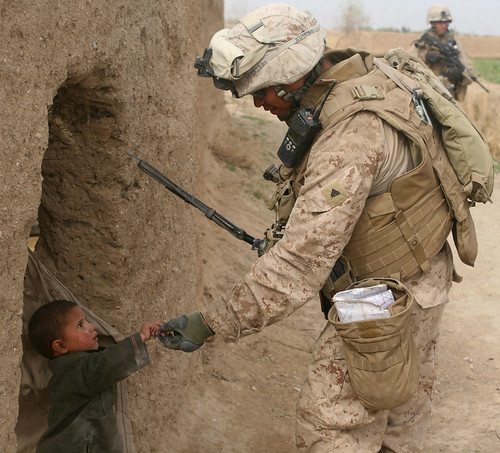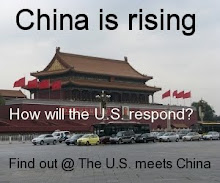One of the major revelations to come out of the 92,000 previously classified documents recently released by wikileaks is that apparently the Taliban have on several occasions fired at U.S aircraft using surface to air missiles better known as MANPADS (Man Portable Air Defense Systems). The media has seized upon this story as yet another government blunder since after all wasn't it the U.S. government who originally supplied the Mujahideen with stinger missiles back in the 80's when they were fighting the Soviets? However, a closer examination of the specs on these stingers leads one to a far different and perhaps more dangerous conclusion; that Pakistan has begun to supply the Taliban with their own surface to air missiles to use against U.S. forces.
I had often heard that there were several hundred stingers unaccounted for after the withdrawal of Soviet forces from Afghanistan and when I was there this summer I asked the crews of helicopters I was flying on why it was that we no longer considered these weapons a threat. According to weapons experts, the batteries on stinger missiles are good for one shot each and they must be changed out if the delivery system is to be used more than once. Furthermore, the average shelf life of unused batteries is only 4-5 years. Meaning that any stinger missiles given to the Mujahideen in the 80's would no longer be effective today. While it is not beyond the realm of contemplation that a skilled technician could jerry rig some sort of alternative battery for these devices, such skill is likely out of the range of the vast majority of Taliban. These weapons are however still capable of exploding, only the delivery device is deactivated. As such a great deal of the remaining stingers left over from the 80's have probably since been turned into IEDs.
The fact remains however that the Taliban are getting fully functioning MANPADS from somewhere, which in all likelihood have been constructed in the last 4-5 years. The most likely candidate is Pakistan which is both the traditional patron of the Taliban and has for the last twenty years been a manufacturer of their very own surface to air missile known as the Anza. The Anza has an effective range of up to 5000 meters and could certainly have been behind the downing of several US helicopters in recent years. In recent years, Pakistan has advertised the Anza series for export,displaying it at the International Defense Exhibition (IDEX) 2007 event in the UAE.
Worst case scenario: The Pakistani ISI is directly providing the Taliban with surface to air missiles
Best Case: Pakistan is irresponsibly selling MANPADS on the open market and they are ending up in the hands of the Taliban through a middleman
The always-superb Rajiv Chandrasekaran has a story in the Washington Post about progress in Afghanistan, comparing the lack of it in Marja (a "bleeding ulcer," as General McChrystal famously said) with the relative tranquility and prosperity of Nawa. Both hamlets are similar demographically and geographically, but while Marja continues to hemorrhage Nawa is creeping forward.
Both were stricken by the Taliban insurgency four years ago. And over the past year, both have been treated with America's new counterinsurgency formula: Each community has been flooded with U.S. Marines and Afghan security forces, at troop levels that meet or exceed what counterinsurgency theorists prescribe. Each has received a surge of cash and civilian experts in an effort to provide public services, rebuild infrastructure and dole out basic economic assistance. Each has been described as a priority by the central government in Kabul. So why did all this work in one but not the other?
 |
| Photo by Lance Cpl. Tommy Bellegarde |
Unfortunately, this is the wrong question. It rests on the assumption that the U.S. did something right in Nawa but something wrong in Marja, and the only thing to do is discover that error. At a deeper level, the assumption is that all events are conclusively influenced by U.S. policy - we can do it right or do it wrong, but ultimately we are the ones determining the outcome. I find this idea troubling. Accepting that the U.S. military is the decisive factor in the near-term future in Afghanistan means neglecting local relations and politics, national governance (or the lack thereof), and a host of other factors, not the least of which is the most fundamental of all military strategy - the enemy gets a vote.
Chandrasekaran almost hits on this point, but quickly loses the thread:
But the residents also emphasized that the Taliban fighters left of their own accord. "They chose to flee from here," said one shopkeeper. "They drove away as soon as the Marines arrived."In other words, perhaps the success in Nawa was not the result of superior American tactics, but rather of a Taliban miscalculation. Their failure in Nawa may have been part of the reason the Taliban refused to flee Marja; an attempt to avoid repeating the mistake.
So what does this mean for U.S. operations in Afghanistan? It's a reminder that actors and events that are not part of the plan influence the outcome, sometimes decisively. As the Bush Administration learned in the aftermath of the fall of Baghdad, unplanned events occur and must be dealt with, even if that means discarding the original blueprint. COIN doctrine cannot be implemented according to any book, and the notion that there is a "right" way to do COIN which guarantees success is a fallacy. Perhaps General Petraeus has taken a similar lesson from recent events. He has reportedly decided to scrap the invasion Kandahar, calling the current plan "not an appropriate model." Kudos to P4 for making the right call, and hopefully this is only the first of many.
Share This! (the gift that keeps on giving)
Latest Analysis
D&D Contributors
The D&D Vault
-
▼
2010
(168)
- 10/17 - 10/24 (2)
- 10/10 - 10/17 (1)
- 09/26 - 10/03 (2)
- 09/19 - 09/26 (2)
- 09/12 - 09/19 (1)
- 08/29 - 09/05 (1)
- 08/22 - 08/29 (2)
- 08/08 - 08/15 (1)
- 08/01 - 08/08 (1)
- 07/25 - 08/01 (2)
- 07/18 - 07/25 (3)
- 07/11 - 07/18 (2)
- 07/04 - 07/11 (5)
- 06/27 - 07/04 (2)
- 06/20 - 06/27 (9)
- 06/13 - 06/20 (3)
- 06/06 - 06/13 (1)
- 05/30 - 06/06 (3)
- 05/23 - 05/30 (1)
- 05/16 - 05/23 (1)
- 05/09 - 05/16 (2)
- 05/02 - 05/09 (2)
- 04/25 - 05/02 (4)
- 04/18 - 04/25 (6)
- 04/11 - 04/18 (8)
- 04/04 - 04/11 (8)
- 03/28 - 04/04 (9)
- 03/21 - 03/28 (5)
- 03/14 - 03/21 (2)
- 03/07 - 03/14 (5)
- 02/28 - 03/07 (8)
- 02/21 - 02/28 (8)
- 02/14 - 02/21 (10)
- 02/07 - 02/14 (13)
- 01/31 - 02/07 (8)
- 01/24 - 01/31 (11)
- 01/17 - 01/24 (8)
- 01/10 - 01/17 (6)




.jpg)